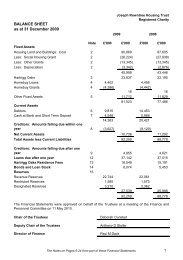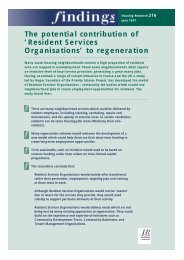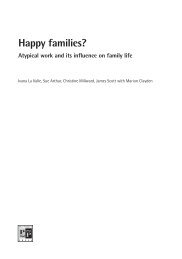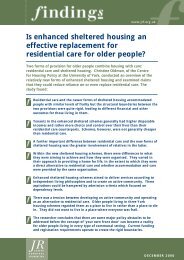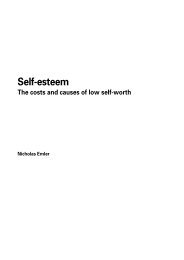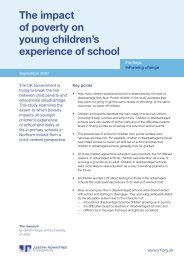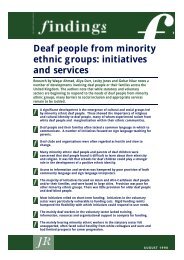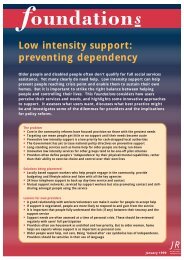Community participation - Joseph Rowntree Foundation
Community participation - Joseph Rowntree Foundation
Community participation - Joseph Rowntree Foundation
Create successful ePaper yourself
Turn your PDF publications into a flip-book with our unique Google optimized e-Paper software.
<strong>Community</strong> <strong>participation</strong><br />
Principles into practice<br />
The message from our research is that, no matter how hard people try, existing<br />
forms of community <strong>participation</strong> in governance will only ever mobilise a small group<br />
of people. Rather than fight against this reality, the solution lies in maximising the<br />
value from the existing small group, while also looking at longer-term approaches to<br />
governance that would create a broader bedrock of support for governance activity.<br />
The suggestions here would help to move towards that aim of working incrementally<br />
with the grain of existing patterns in people’s <strong>participation</strong>, rather than creating<br />
transformation by radically shifting our approach to governance.<br />
Two clear objectives for policy and practice can be discerned: first, to mobilise 1 per<br />
cent <strong>participation</strong>; second, to embed this <strong>participation</strong> in the wider rhythms and<br />
routines of community life. What kinds of interventions might help to realise these<br />
objectives? The seven ideas that follow are not recommendations as such; rather,<br />
they are intended as illustrations of what The 1% Solution might mean in practice.<br />
Backing the best 1 per cent<br />
If 1 per cent formal <strong>participation</strong> is the best we can aim for, we can still do much<br />
more to ensure that it is the best 1 per cent and that they are liberated as far as<br />
possible to actually get things done for their community. As Paul Brickell explains,<br />
this approach makes us somewhat squeamish since:<br />
It suggests that power and decision-making in disadvantaged<br />
neighbourhoods might be vested in individuals and groups who ‘can<br />
deliver’, rather than in representative, elected committees and boards. It<br />
starts with people, rather than representative structures, and so<br />
challenges the dominant notion of what constitutes democratic legitimacy<br />
… Rather than seeing devolution in terms of creating more politicians and<br />
more institutions, it involves a further redistribution of power and decisionmaking<br />
discretion. 11<br />
The lesson of people like Greg is that, so long as there is more than one way to ‘do’<br />
representativeness, our approaches to devolving power to communities need to<br />
accommodate different 1 per cents, authorised in different ways, empowered with<br />
different resources and whose legitimacy is measured on terms dictated by the<br />
community they serve.<br />
54




